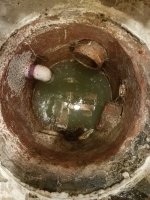I opened up a pit that is used for sanitary waste in the basement but discovered some clay lines running into it. Ran a camera through the clay lines and discovered they were dry and filled with what looks like gravel about 16ft into the line. I'm wondering if those lines are original drain tile?
I also discovered it doesn't have a bottom. It's just dirt. I do remember now that the pump does turn on during rain, but it might be filling in from the bottom?
I plan on getting this fixed but need to know if rain water drains into it? Why would there be gravel 16ft into the line?
I also discovered it doesn't have a bottom. It's just dirt. I do remember now that the pump does turn on during rain, but it might be filling in from the bottom?
I plan on getting this fixed but need to know if rain water drains into it? Why would there be gravel 16ft into the line?

